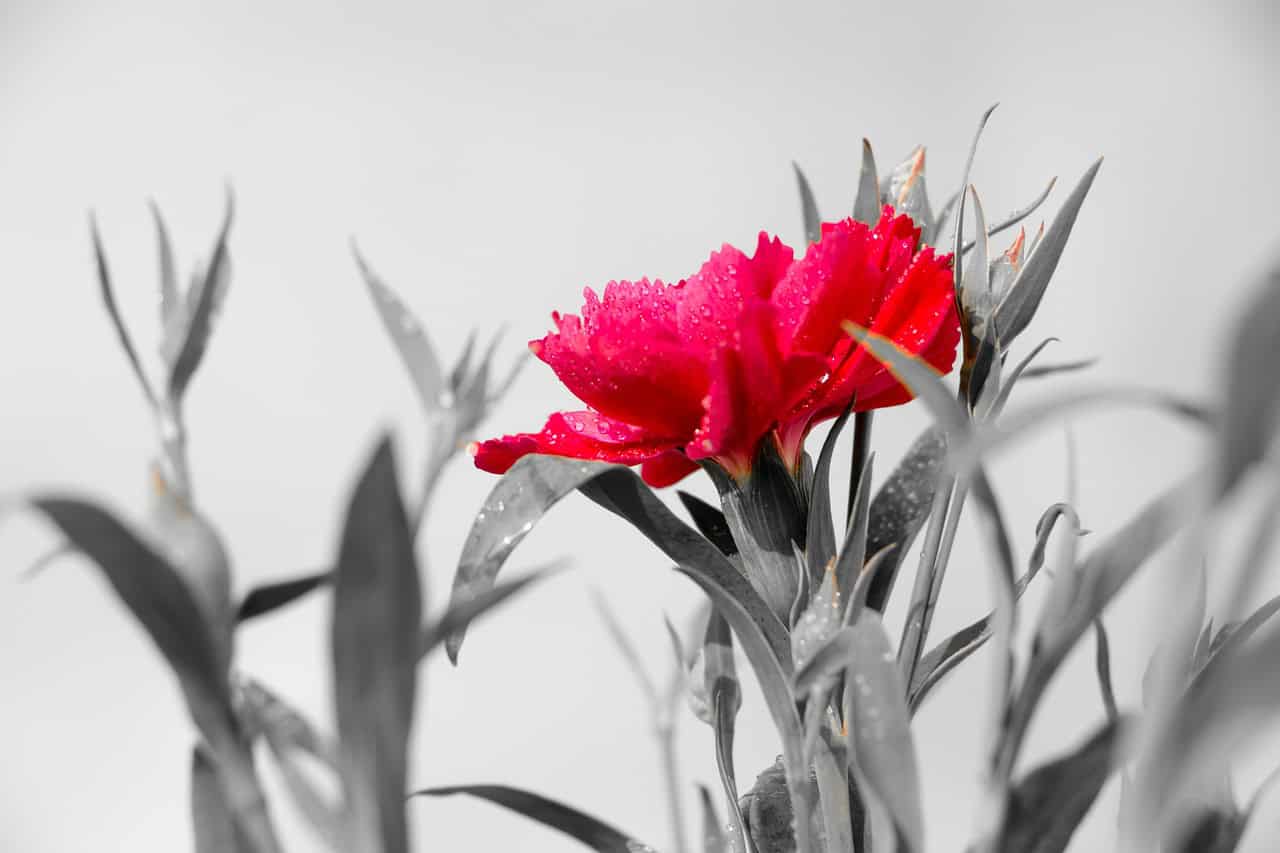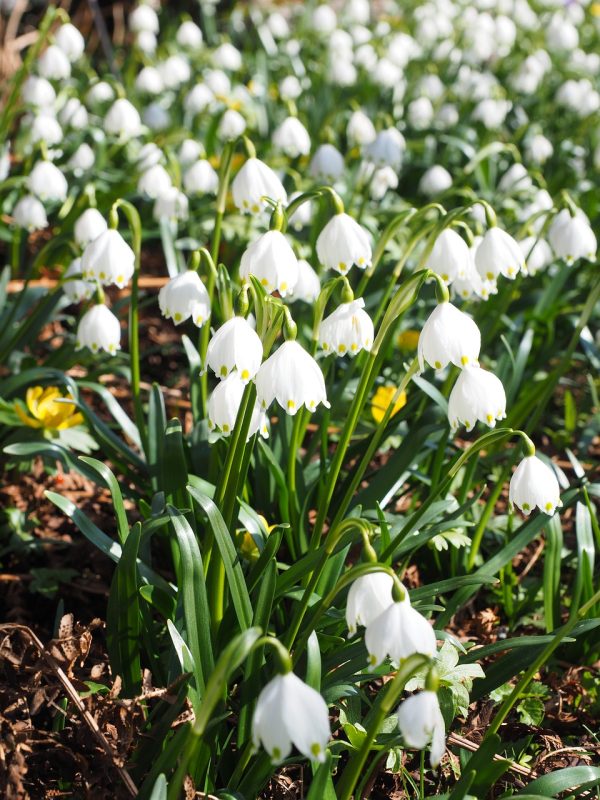Amaryllis
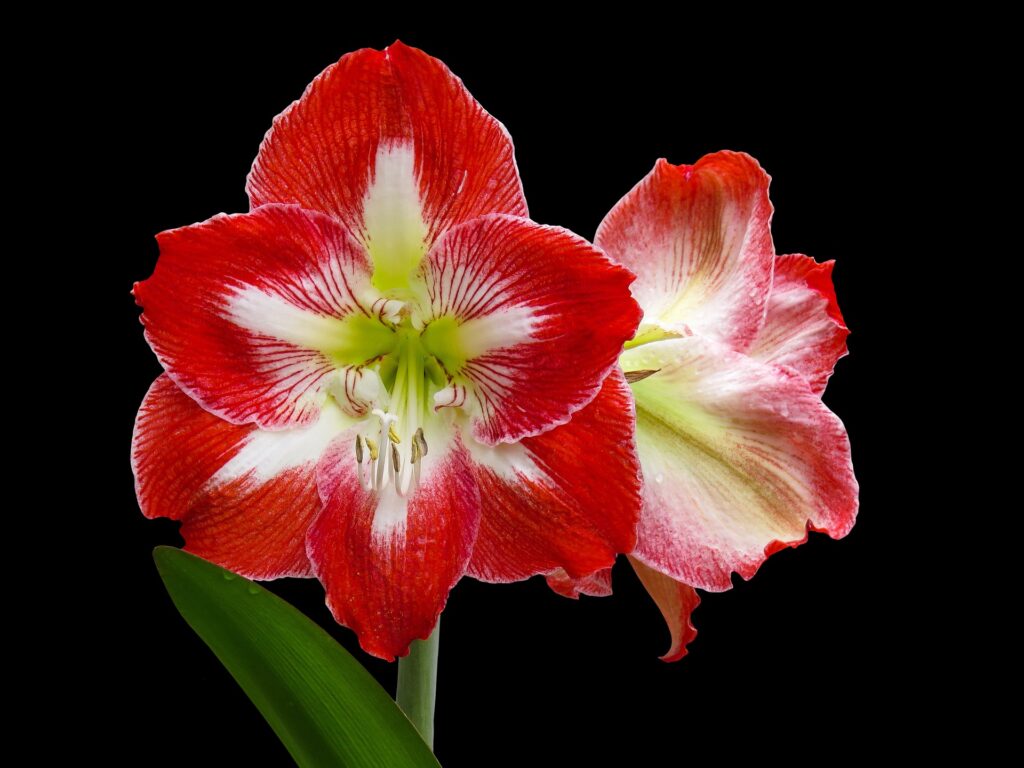
The Amaryllis, often renowned for its striking, trumpet-shaped flowers, is a winter favorite that encapsulates the essence of seasonal beauty. Native to the tropical regions of South America, this bulbous plant is cherished not only for its majestic blooms but also for its ability to bring vibrant color to the often dreary winter landscape. The Amaryllis blooms can range in hues, including deep reds, luminous whites, and cheerful pinks, making them versatile for various decor styles.
One of the most enchanting aspects of Amaryllis is how it serves as a harbinger of the festive season. It can flourish indoors or out, and many gardeners choose to force the bulbs to bloom in December, coinciding perfectly with holiday celebrations. The plant typically reaches a height of 2 feet or more, with clusters of flowers erupting from thick stalks, creating a stunning focal point on mantels, tabletops, and windowsills.
Caring for Amaryllis is a rewarding process. These bulbs thrive in well-draining soil and require minimal water during their dormancy phase, making them relatively easy to manage. Post blooming, it is advantageous to continue nurturing the plant, allowing the foliage to photosynthesize and store energy for the next flowering cycle. With proper care, these bulbs can last for years, providing spectacular winter blooms for many seasons.
Calendula
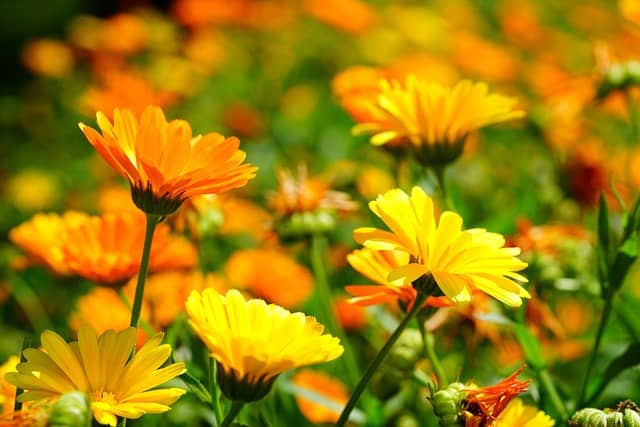
Often overlooked in discussions about winter flora, Calendula is a hardy plant that can add a splash of color to gardens even during the colder months. While many associate calendulas with summer gardens, certain varieties, particularly the pot marigold (Calendula officinalis), are known for their resilience and ability to bloom in winter conditions. These bright, cheerful flowers can light up dreary days with their sunny yellow and orange petals.
Calendula is not just a pretty face; it also boasts a plethora of beneficial properties. Often utilized in herbal remedies, the petals are rich in antioxidants and have anti-inflammatory properties, making them a natural choice for skincare or culinary uses. When grown in winter, Calendula can provide a source of fresh petals for salads, garnishes, and teas, allowing gardeners to enjoy harvests even in the bleakest of seasons.
For optimal growth during the winter, plant Calendula in a well-drained garden bed with plenty of organic matter to help retain moisture. Running a row cover over the plants can protect them from frost while still allowing sunlight to nourish their growth. This adaptability not only makes Calendula a resilient addition to winter gardens but also an eco-friendly choice that supports pollinators during the off-season.
Camellia
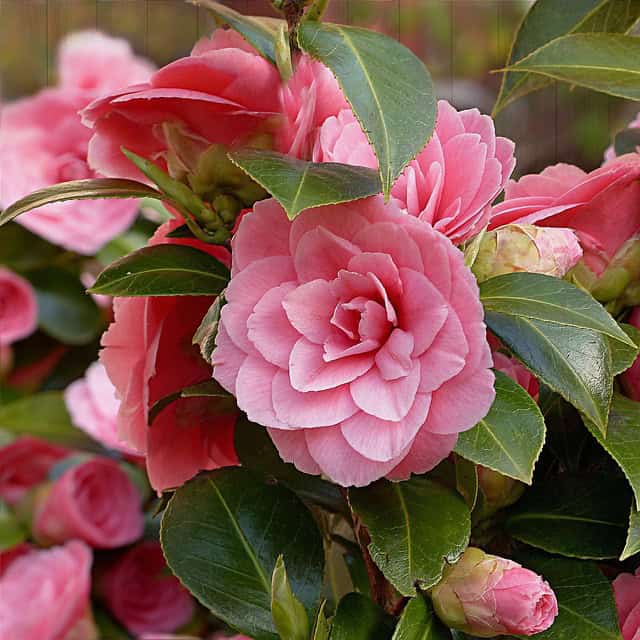
The Camellia, an evergreen shrub with glossy leaves, is synonymous with winter elegance. Blooming from late winter to early spring, Camellia flowers herald the onset of new life, often gracing gardens with their velvety blossoms in shades of pink, white, or deep red. A hallmark of southern gardens, these florals have a storied history and cultural significance, being admired for centuries for their beauty and versatility.
One of the most unique traits of Camellia is its capacity to thrive in partial shade, making it an exceptional choice for woodland gardens or areas with dappled sunlight. Camellias prefer acidic, well-draining soil and benefit from a layer of mulch to protect their roots from sudden temperature fluctuations. This makes them a versatile choice for various garden settings, able to provide interest when many other plants lie dormant.
Beyond their aesthetic appeal, Camellia flowers have also found a place in tea culture, particularly in Asian cuisine. The leaves of the Camellia sinensis plant are harvested to produce varieties of tea, which add another dimension to understanding this remarkable plant. Camellias can effortlessly shift the mood of a winter garden, encapsulating grace and resilience, proving that even in the coldest months, beauty can blossom beautifully.
Christmas Cactus
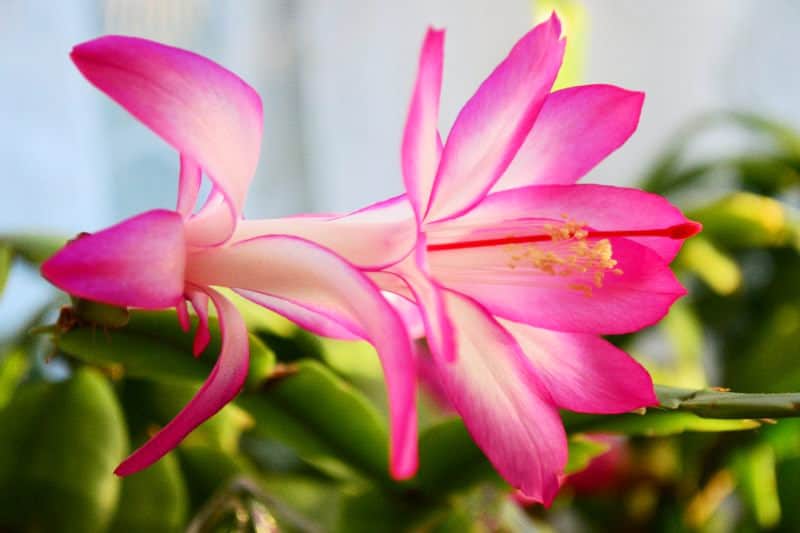
The Christmas Cactus, scientifically known as Schlumbergera, is a delightful succulent that not only provides a burst of color during the dreariest winter months but also serves as a potent symbol of holiday cheer. With its unique segmented stems and vibrant, tubular blooms in shades of pink, red, and white, this plant can light up any home with its festive flair. Unlike traditional cacti, which are known for their sharp spines, the Christmas Cactus features soft, leaf-like segments that make it a popular choice for avid gardeners and new plant enthusiasts alike.
One fascinating aspect of the Christmas Cactus is its adaptability to indoor environments. It thrives in bright but indirect light, making it an excellent choice for window sills or living rooms that receive filtered sun. To encourage blooming, it’s crucial to mimic the natural conditions of its native Brazilian rainforest habitat, where the plant naturally experiences cooler temperatures and lower light conditions during winter. As such, it often blooms around the holidays, hence its name.
Care for a Christmas Cactus is relatively straightforward. It prefers to be slightly root-bound, so it’s best to avoid repotting too frequently. The plant thrives on humidity, so occasional misting or placing it near a humidifier can enhance its overall health and blooming potential. Beyond its aesthetic appeal, the Christmas Cactus embodies the spirit of the season and is often passed down through generations, making it a living heirloom that connects families during the holiday celebrations.
Crocus

Among the first harbingers of spring, the Crocus is a delightful flower that surprisingly begins to emerge in late winter. Known for their charming cup-shaped blooms, Crocuses (from the family Iridaceae) can add a vivid touch to the winter landscape, often peeping through the remnants of snow to announce the approaching end of winter. With colors ranging from brilliant yellows and purples to pristine whites, these flowers create a tapestry of color that can uplift even the gloomiest days.
Crocuses are particularly resilient and can withstand colder temperatures due to their unique bulbous structure. They store energy in their bulbs, allowing them to flourish with minimal resources. These flowers prefer well-draining soil and full to partial sunlight, which helps them maximize their blooming potential. Planting Crocus bulbs in clusters can create spectacular displays, transforming a dreary garden into a vibrant celebration of nature’s tenacity.
An interesting feature of Crocus flowers is that many species contain a compound called crocin, which is responsible for their golden color. This compound not only gives color to the flowers but is also known for its medicinal properties, making Crocus a colorful addition to herbal practices. Whether planted in garden beds, rockeries, or pots, Crocuses are a fantastic winter flower choice, serving as a reminder that beauty and resilience can emerge even in the coldest of seasons.
Cyclamen
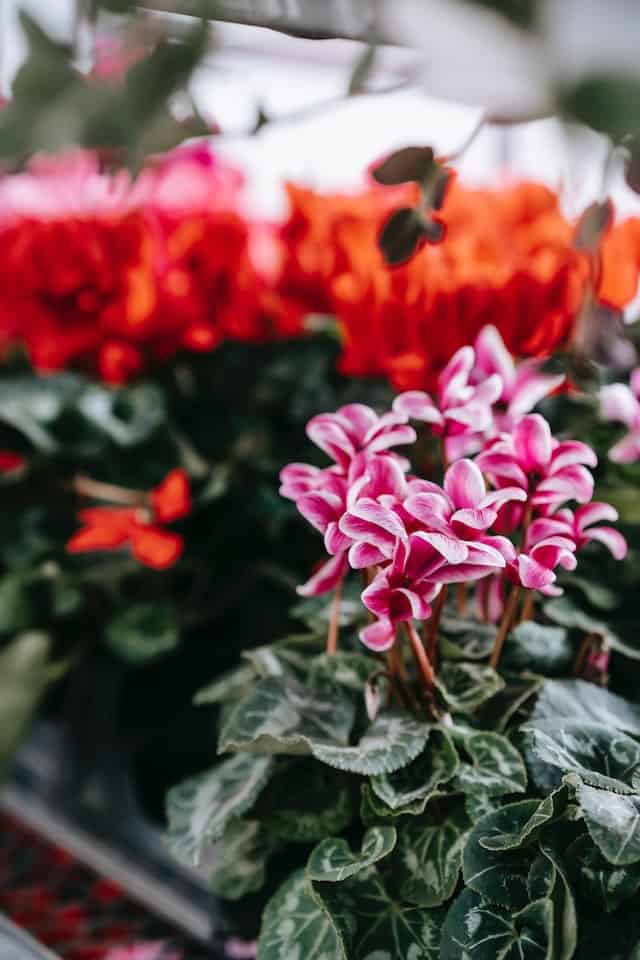
Cyclamen are another remarkable group of winter flowers that can infuse gardens and homes with a sense of grace and elegance. Known for their unique heart-shaped leaves and delicately nodding flowers, Cyclamen add a touch of charm wherever they grow. Available in hues of pink, red, purple, and white, their petals often display intricate patterns that captivate any onlooker. Native to the Mediterranean region, these perennial plants thrive in moist, well-drained soils and are commonly used as winter bedding plants or potted indoor displays.
One of the most captivating elements of Cyclamen is their flowering behavior—these plants produce blooms that seem to float above the foliage, creating a striking visual effect. They are typically in full bloom from late winter to early spring, although the flowering period can vary depending on the species and environmental conditions. Their enchanting appearance is further complemented by a pleasant, subtle fragrance that can evoke a sense of calm and serenity.
Cyclamen are relatively easy to care for once their needs are understood. They prefer cooler temperatures and should be watered from below to prevent water from collecting in the crown, which can lead to rot. Additionally, providing them with a period of dormancy in the summer can help ensure vibrant blooms when winter arrives. The beauty of Cyclamen lies not only in their aesthetic appeal but also in their symbolism of love and affection, making them a thoughtful gift during the winter months, adding both beauty and meaning to any floral arrangement or winter garden.
Daffodils
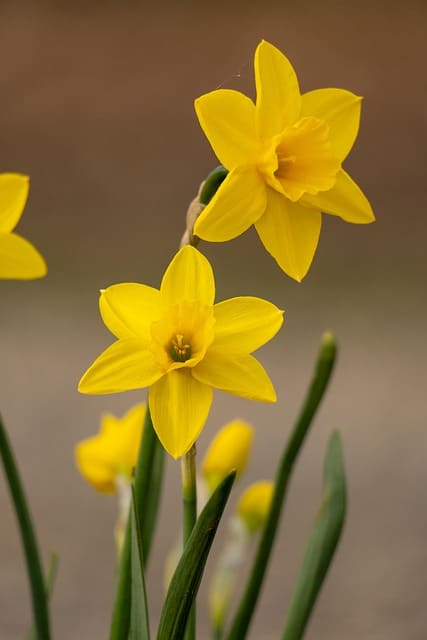
Daffodils, belonging to the genus Narcissus, are iconic harbingers of spring, but their ability to thrive during the tail end of winter makes them a much-anticipated sight in gardens. These cheerful flowers, with their trumpet-shaped blooms often adorned in sunny yellows, whites, and oranges, symbolize rebirth and renewal, serving as a beacon of hope after the cold and darkness of winter.
While traditionally associated with spring, many daffodil varieties can push through the soil frost and bloom even in late winter’s chill, particularly in mild climates. Their resilient bulbs are adept at storing energy, making them one of the earliest flower types to blossom after the harshest months. Planting daffodils is not only a beautiful seasonal practice but also provides a vital food source for pollinators emerging from hibernation.
Care for daffodils is relatively simple. They flourish in well-drained soil and prefer areas with full sunlight. Once the blooms fade, gardeners should allow the leaves to die back naturally to replenish the bulb’s energy for next year’s blooms. Interestingly, daffodils produce a chemical called narcissus, which deters browsing animals, making them a great choice for gardens where deer or rabbits might be a concern. Their natural resilience and radiant beauty make daffodils an essential addition to any winter flower collection, signaling that warmer days are on the horizon.
Daphne
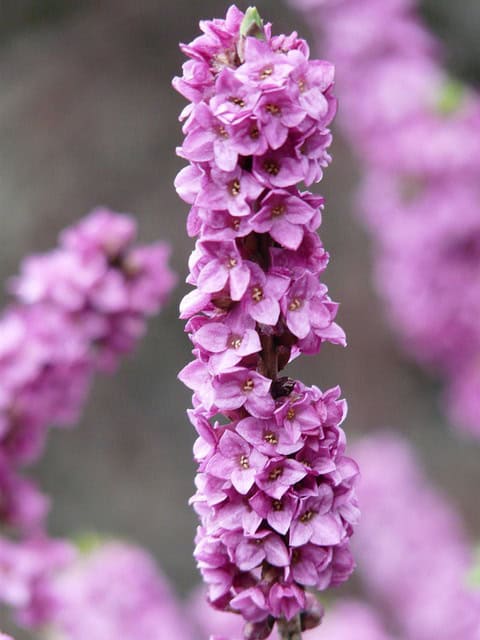
Daphne is a genus of flowering shrubs known for their intoxicating fragrance and delicate blossoms, captivating anyone fortunate enough to encounter them in late winter. One of the most beloved species is Daphne odora, also known as winter daphne, which produces clusters of small, pale pink to white flowers that release a sweet scent, often described as a mixture of floral and citrus notes. This enchanting aroma makes winter gardens come alive when many other plants remain dormant.
What sets Daphne apart as a winter flower is its evergreen foliage, which provides year-round visual interest. The glossy leaves contrast beautifully with the pastel hues of its blooms, and when the flowers emerge in late winter, they create a stunning display that is as aromatic as it is visually appealing. Daphnes thrive in sheltered, well-drained locations and prefer slightly acidic soil, making them a lovely addition to woodland gardens or borders.
However, it’s worth noting that Daphne can be somewhat finicky to grow. While they don’t require extensive care, they do necessitate attention to their watering needs, as over-saturation can lead to root rot. Furthermore, some species are slow to establish, requiring patience from gardeners eager for blooms. Nevertheless, the reward of their fleeting, fragrant flowers during winter makes them an invaluable plant for those looking to deepen their garden’s sensory experience.
Distylium

Distylium, a lesser-known but intriguing winter flower, belongs to the witch hazel family and is gaining popularity among gardeners for its unique characteristics and year-round appeal. With its evergreen foliage, the plant typically provides constant greenery, but it also produces small, cup-shaped flowers that bloom in late winter to early spring. These flowers, which can be red or purplish in color, are often overlooked because of their small size but can create a stunning effect when viewed en masse.
What makes Distylium particularly appealing to gardeners is its incredible adaptability and resilience. It thrives in a variety of soil types and is drought-tolerant once established, making it suitable for various landscape designs, including low-maintenance gardens. Additionally, the plant offers excellent resistance against pests and diseases, which can be a significant advantage in home gardens. Its evergreen nature provides a solid backbone to garden designs, allowing for creativity in layering other seasonal plants.
Caring for Distylium is relatively uncomplicated. It prefers full sun to partial shade, and while it’s tolerant of different soil conditions, ensuring proper drainage is crucial for its health. As it establishes, gardeners can prune it to shape and encourage denser growth, enhancing its overall visual impact. With their subtle beauty and robust nature, Distylium offers a fresh take on winter flowers, making it a smart choice for those wanting to create a garden that thrives through the seasons.
Dutchman’s Breeches
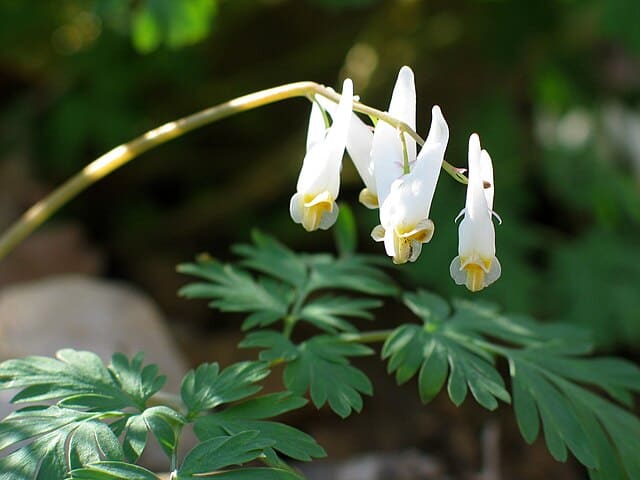
Dutchman’s Breeches (Dicentra cucullaria) is a captivating wildflower that offers a unique visual charm during the late winter and early spring seasons. Named for its whimsical, bilobed flowers that resemble a pair of white pants hanging upside down, this perennial plant adds an enchanting touch to woodland gardens and shady spots. The delicate blooms emerge in clusters atop fern-like foliage, creating a striking contrast against the rich greens, and often bloom as early as March, depending on the climate.
This plant thrives in well-drained, moist, and rich soil, typically found in deciduous forests, where it benefits from the dappled sunlight that filters through the trees before the leaves fully emerge. As a spring ephemeral, Dutchman’s Breeches completes its life cycle quickly; after blooming, the foliage dies back, allowing other plants to take center stage in the garden. This unique lifecycle can provide useful strategies in garden planning, as its early presence can support pollinators like bees and butterflies, drawn to its nectar-rich flowers.
Dutchman’s Breeches is also notable for its medicinal uses by indigenous peoples, who tapped into its natural properties for treatments. Although it is not commonly used in modern herbalism, its historical context reflects the plant’s importance in traditional remedies. Given its combination of beauty, ecological value, and historical significance, Dutchman’s Breeches is a fantastic addition to any winter garden that celebrates the arrival of spring.
English Primroses
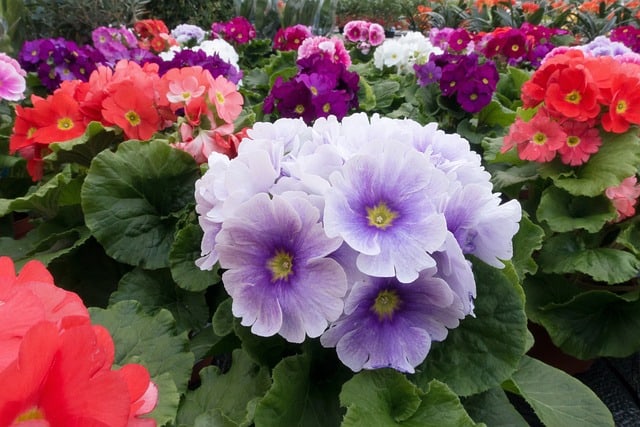
English Primroses (Primula vulgaris) are a beloved emblem of winter and early spring gardens, offering a joyful palette of colors that range from delicate yellows to vibrant purples and pinks. These perennial flowers are known for their rosettes of soft green leaves, which provide a lush backdrop for the lovely blooms that typically emerge in late winter, often bringing warmth and cheer to landscapes still recovering from the bleakness of winter.
Primroses thrive in moist, rich soil and prefer partial shade to full sun, making them a versatile choice for various garden environments. Their ability to bloom in the cooler temperatures of early spring allows them to produce flowers before many other plants have started their growth cycles, making them particularly valuable in gardens where early color is desired. The English Primrose is also suitable for container gardening and can be used to create stunning indoor displays.
Another fascinating aspect of English Primroses is their cultural significance. They have long been associated with the arrival of spring, symbolizing new beginnings and rebirth in literature and folklore. The soothing fragrance of primroses has also made them a favorite in perfumery, highlighting their multifaceted appeal. For gardeners looking to enhance their winter landscapes with vibrant colors and rich historical significance, English Primroses are a perfect choice for an enchanting seasonal display.
Glory of the Snow
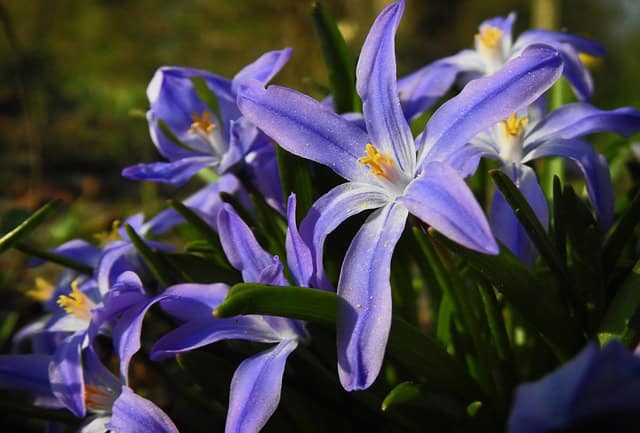
Glory of the Snow (Chionodoxa luciliae) is a charming bulbous perennial that transforms winter gardens with its stunning blue and white star-shaped blooms. This delightful flower is one of the first to appear in the spring, often breaking through the last remnants of snow, hence its cheerful name. Each flower features six petals that radiate from a central yellow heart, creating a vivid contrast that captivates onlookers and signals the changing of the seasons.
This low-growing plant thrives in well-drained soil and prefers sunny to partially shaded locations, making it an excellent choice for rock gardens, borders, or as ground cover. The bulbs can naturalize over time, multiplying and creating a delightful carpet of blue in your garden. Glory of the Snow can bloom as early as March, sometimes even before the thaw, introducing color and life in an otherwise dormant landscape.
What sets Glory of the Snow apart from other winter flowers is its remarkable resilience to colder temperatures, allowing it to flourish in various climates. Moreover, it is deer-resistant, making it a practical choice for gardens frequented by wildlife. This enchanting flower not only beautifies winter landscapes but also serves a vital role in attracting early pollinators, contributing to the health and diversity of the garden ecosystem. For those looking to create a vibrant winter garden that remains captivating even as the seasons change, Glory of the Snow is an ideal choice.
Hellebores
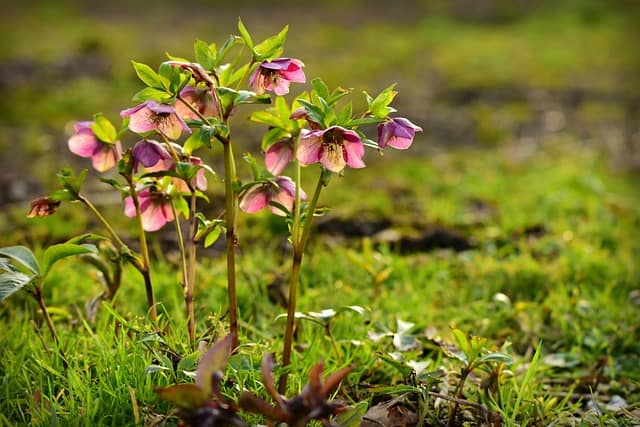
Hellebores, often referred to as the “Christmas Rose” or “Lenten Rose,” are celebrated for their striking blooms that add unexpected elegance to winter gardens. Known scientifically as Helleborus, these perennial flowers are among the first to bloom in late winter to early spring, often elevating the garden aesthetic with their rich colors, which can range from delicate pastels to deep hues. Apart from their beautiful petals, the flowers are often unique in appearance, featuring outward-facing blossoms that can resemble chalices and create a stunning visual interest in the landscape.
Hellebores thrive in shaded or partially shaded areas, preferring rich, well-drained soil. They are exceptionally hardy and can endure frost, providing a burst of color during the cold months when many other plants lie dormant. Their evergreen foliage adds another layer of beauty throughout the winter, serving both as a backdrop for their striking flowers and as a lush feature in itself, with leathery leaves that can withstand harsh weather conditions.
One intriguing aspect of Hellebores is their long flowering period. Depending on the species and local climate, they can bloom as early as January and continue showcasing their beauty through March, creating a bridge between winter and spring. Additionally, their low maintenance needs make them a favorite among gardeners; once established, Hellebores can thrive for years with little intervention. Their ability to attract early pollinators further enhances their value in the ecosystem, making them an excellent choice for those invested in both garden aesthetics and ecological health.
Lenten Rose
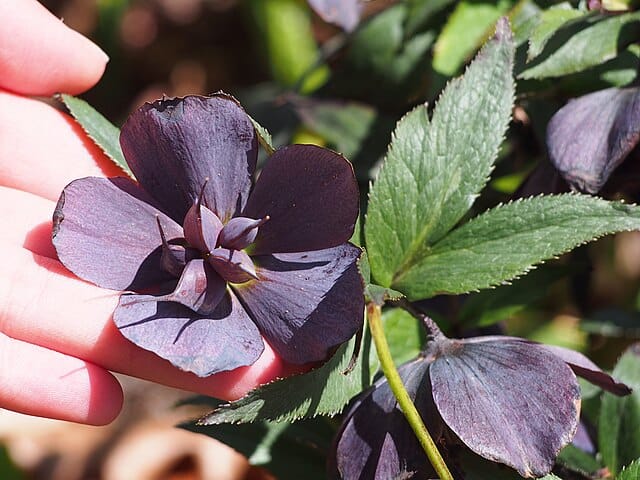
The Lenten Rose (Helleborus orientalis) is a captivating member of the Hellebore family that is particularly beloved for its early spring bloom that often coincides with Lent, hence its name. This hardy perennial showcases an array of stunning flowers in various colors, from creamy white and soft pinks to deep purples and nearly black shades. The petals can also feature unique markings that enhance their allure, giving each bloom its personality, thus enriching any winter garden or shaded nook.
Lenten Roses thrive in similar conditions to their Hellebore cousins—preferring well-drained, rich soil and partial to full shade. What sets them apart is their specific adaptation to various environments, making them suitable for garden beds, under trees, or as ornamental container plants. Their ability to tolerate cold temperatures while also thriving in shaded areas makes Lenten Roses an excellent choice for those looking to add a pop of color to less sunny spots.
Notably, Lenten Roses are also celebrated for their longevity and resilience. Once planted, they can continue to bloom and thrive for many years, often requiring little care beyond the occasional pruning to remove faded leaves. Some varieties can even bloom for several months, making them one of the more prolonged flowerers for winter gardens. Additionally, they have historical significance in traditional herbal medicine, although care must be taken as some parts of the plant are toxic. This blend of beauty, resilience, and history makes the Lenten Rose a true gem for any gardener seeking to enrich their outdoor spaces.
Mahonia
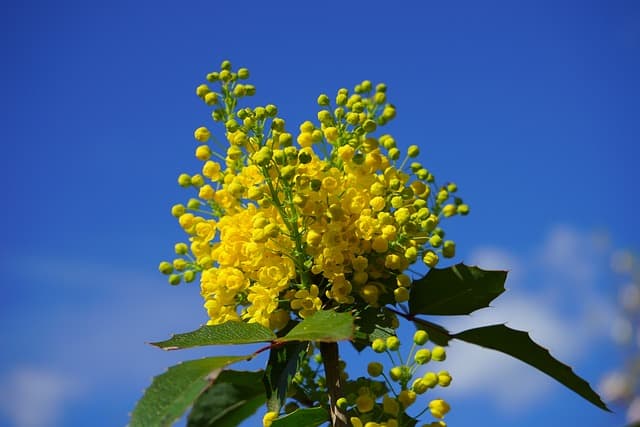
Mahonia, commonly known as Oregon grape, is a unique evergreen shrub that brightens winter gardens with its glossy, spiky leaves and clusters of bright yellow flowers. Native to the western United States, Mahonia (Mahonia aquifolium) takes on a bold presence in the landscape, thriving in part to full shade and providing excellent coverage throughout the winter months. The rich, holly-like leaves create a striking backdrop for the cheery yellow blossoms that typically appear in late winter to early spring, attracting a host of pollinators, including bees, looking for early nectar sources.
What makes Mahonia particularly appealing is its adaptability to various garden styles, from woodland gardens to more formal landscapes. Additionally, its ability to tolerate drought and poor soil conditions makes it a low-maintenance option for gardeners keen on creating vibrant, resilient spaces. After flowering, the plant produces blue-purple berries that not only attract birds but may also be used in jams and jellies, highlighting its multipurpose nature.
Beyond its aesthetic and ecological contributions, Mahonia has notable medicinal properties, often used in traditional herbal remedies for its anti-inflammatory and antibacterial qualities. The various compounds found in its leaves and berries have been celebrated in Indigenous cultures for centuries. For those looking to cultivate a winter garden that is not just visually appealing but also rich in ecological and historical significance, Mahonia provides a fascinating option that brings texture, life, and color during the colder months.
Ornamental Cabbage and Kale
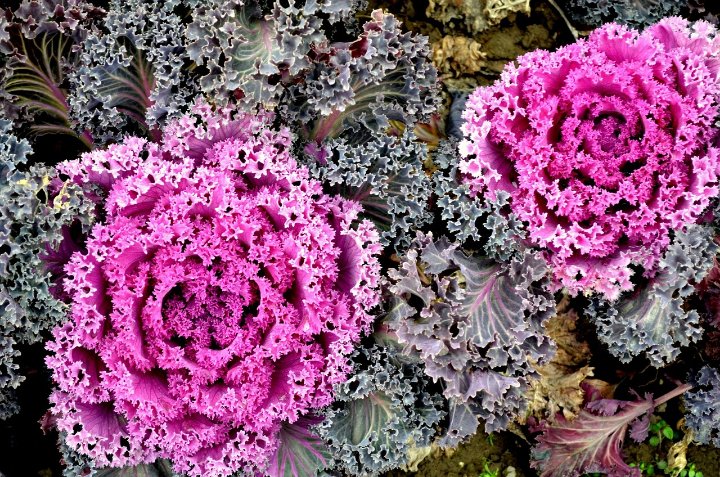
Ornamental cabbage and kale (Brassica oleracea var. acephala) offer a striking visual element to winter gardens with their vibrant colors and unique foliage. Unlike culinary varieties, these ornamental crops are bred specifically for their aesthetic qualities, showcasing a stunning palette of purples, pinks, whites, and greens that can brighten even the gloomiest winter days. The texture of their broad leaves, often frilled or ruffled, adds depth and interest to garden beds, containers, and even as edging plants.
These hardy plants thrive in cool temperatures, making them perfect for fall planting. Generally, ornamental cabbage and kale can endure frost and even snow, often intensifying their colors when exposed to cold weather. This resilience provides seasonal continuity in gardens, allowing for captivating displays that transition seamlessly from autumn into winter. They can be used in a variety of design styles—from formal to cottage gardens—adding a touch of elegance with their unique shapes.
Care for ornamental cabbage and kale is straightforward. They prefer full sun to partial shade and can flourish in a range of soil types, although rich, well-drained soils will yield the best results. Their low-maintenance nature and ability to withstand cold make them an excellent choice for gardeners looking to add winter interest without extensive care. Moreover, they can provide edible greens up until the harshest frost, allowing for dual purposes in the landscape. With their radiant colors and versatility, ornamental cabbage and kale are undeniable stars in the winter garden.
Pansies

Pansies (Viola tricolor var. hortensis) are beloved winter flowers that add a splash of color to gardens when many other blooms have receded. With their large, vibrant petals adorned with unique patterns and colors, pansies are often seen as the cheerful face of winter gardens. They are remarkably adaptable and can be used in various settings, from borders and flower beds to containers and hanging baskets, making them a versatile choice for gardeners wanting to brighten up dreary winter landscapes.
One of the intriguing aspects of pansies is their ability to thrive in cooler temperatures. They can often withstand frost and light snow, allowing them to remain resilient and colorful throughout the winter months. The cool weather can actually enhance the vibrancy of their colors, resulting in a garden filled with bright yellows, deep purples, soft blues, and assorted blends. Pansies typically bloom from late fall through early spring, making them perfect for transitional seasons.
Caring for pansies is relatively easy, as they prefer rich, well-drained soil and thrive in full sun to partial shade. Regular watering is essential, particularly during dry spells, to ensure their continued vibrancy. Pansies can also be deadheaded to promote extended blooms, which adds to their appeal. As early spring approaches, they may even start producing new flowers, further extending their beauty into warmer months. With their charm and resilience, pansies have become staples in winter gardens, captivating gardeners with their ability to continue blooming when many other plants lay dormant.
Pieris Japonica
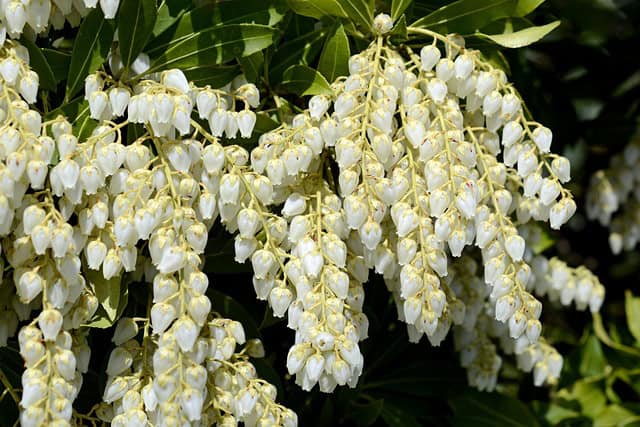
Pieris japonica, commonly known as Japanese Andromeda or lily-of-the-valley shrub, is an evergreen shrub that brings year-round charm to winter gardens. Known for its striking clusters of white or pink bell-shaped flowers that bloom in early spring, Pieris japonica also boasts glossy, lance-shaped leaves that provide a lush contrast against the cold winter backdrop. The rich green foliage turns a beautiful bronze or reddish hue in the winter months, adding another layer of color to the garden.
This shrub prefers acidic, well-drained soil and thrives in part shade to full shade, making it an ideal choice for woodland gardens or shaded areas where sunlight is limited. Its ability to tolerate shade without sacrificing vibrancy ensures that Pieris japonica can be a standout in less conventional garden areas. As winter progresses, its flower buds develop on the tips of new growth, creating a promise of beauty that enhances the sense of anticipation as spring approaches.
In addition to its ornamental attributes, Pieris japonica offers ecological benefits. Its flowers attract early pollinators, including bees and butterflies, providing vital sources of food when few other plants are blooming. The compact growth habit of Pieris japonica makes it suitable for planting as a boundary marker, in low hedges, or as a solitary specimen plant for added interest. Gardeners appreciate its low-maintenance requirements; once established, it often only needs minimal pruning to maintain its shape. With its mix of beauty, ecological value, and adaptability, Pieris japonica proves to be an excellent choice for enhancing winter landscapes.
Poinsettia
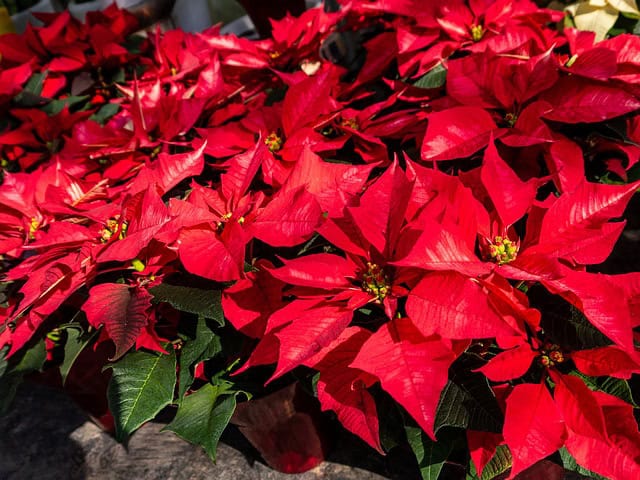
The Poinsettia (Euphorbia pulcherrima) is perhaps one of the most iconic winter flowers, widely recognized for its vivid red and green foliage that adorns homes and gardens during the holiday season. Native to Mexico, this plant has become synonymous with Christmas decorations and festive celebrations. The colorful “flowers” of the Poinsettia are actually modified leaves called bracts, which surround small, inconspicuous clusters of true flowers. These bracts can vary in color, including deep red, white, pink, and even marbled varieties, making Poinsettias a versatile choice for winter displays.
Poinsettias thrive in bright, indirect sunlight, preferring temperatures between 60°F and 70°F. While often treated as short-term holiday decor, they are perennials that can live for years when cared for properly. After the festive season, with suitable watering and humidity, they can be maintained until next winter’s blooming season. Interestingly, Poinsettias are sensitive to changes in light and temperature; growers can manipulate these factors to encourage blooming on schedule for holiday displays.
Beyond their decorative appeal, Poinsettias also hold cultural significance, particularly in Mexican tradition, where they are known as “Nochebuena” (Christmas Eve). Historically, their red color symbolizes the blood of Christ, and the star-shaped flowers are said to represent the Star of Bethlehem. This rich symbolism adds a layer of meaning to the joy these plants bring during the winter season, making Poinsettias not just a beautiful choice but a poignant element of cultural expression.
Pussy Willow

Pussy Willow (Salix discolor) is a charming winter and early spring shrub that brings a unique charm with its distinctive catkins, which appear like soft, fuzzy gray buds. These striking flower clusters, often compared to tiny pompoms, emerge on bare branches before the leaves develop, making them an eye-catching feature in winter landscapes. The bloom typically occurs in late winter to early spring, coinciding with the melt of snow in many regions, creating a lovely juxtaposition against the still-dormant ground.
This versatile shrub thrives best in moist, well-drained soil and prefers sunny locations, making it an ideal choice for waterfront gardens or areas with lots of rain. Pussy Willows are not just beautiful; they are also relatively easy to grow and maintain. They tolerate a range of soil types and conditions, and with regular pruning, they can be shaped into tidy bushes or left to grow naturally, maturing into graceful, arching forms that enhance any landscape.
Pussy Willows also hold a rich symbolic and cultural heritage. In many traditions, their arrival signifies the coming of spring and new life, which is why they are often included in Easter celebrations and used in floral arrangements to symbolize hope and rebirth. Additionally, the soft, furry catkins have made them a favorite in crafting and decorating, often seen in arrangements that add texture and contrast. Incorporating Pussy Willows into winter gardens not only adds visual interest but also deepens the seasonal narrative of renewal and growth.
Scilla
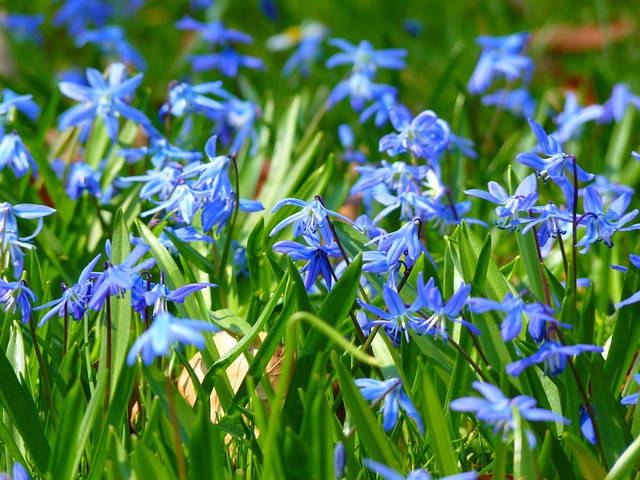
Scilla, commonly known as squill, is a captivating genus of flowering plants that heralds the arrival of spring, often blooming as early as late winter. With its bright blue, violet, or white flowers, Scilla adds a splash of color to gardens as it emerges from the ground, often peeking through remnants of snow. These hardy perennials thrive in various conditions, but they prefer well-drained soil and sunny to partially shaded spots, making them highly adaptable to different garden settings.
One of the unique features of Scilla is its bulbous nature, allowing the plant to store energy and nutrients to survive winter’s chill. When planted in clusters, Scilla creates beautiful drifts of color, which can illuminate borders and woodland areas. These plants also attract early pollinators like bees, who seek them out during the early spring days. As the blooms fade, the foliage remains lush until summer, contributing to garden texture even as other plants begin to dormancy.
Scilla’s historical significance can be traced back to ancient times, where it was appreciated not only for its aesthetic qualities but also for its medicinal properties. In some cultures, parts of the plant were used for various treatments, showcasing its multifaceted roles in herbal traditions. Whether used in formal gardens, rockeries, or naturalized areas, Scilla embodies the spirit of winter flowers, offering resilience and beauty when most other plants are far from bloom.
Snowdrops
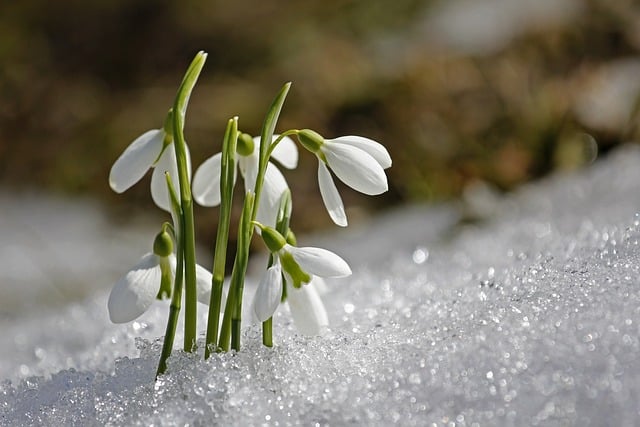
Snowdrops (Galanthus nivalis) are emblematic of winter’s transition to spring, often being among the first flowers to brave the cold and emerge from the melting snow. With their delicate, nodding white flowers resembling teardrops, Snowdrops create a stunning contrast against the winter backdrop, often bringing a sense of hope and joy to gardeners and nature lovers alike. These charming perennial bulbs typically bloom from late winter to early spring, signaling the end of winter’s grasp and the promise of warmer days to come.
Snowdrops thrive in moist, well-drained soil and prefer shaded to partially shaded areas, making them ideal for underplanting in woodlands or difficult-to-plant areas where other flowers might struggle. They are incredibly resilient, able to thrive in challenging conditions and even flowering through frost. Once established, Snowdrops will naturalize and multiply, creating beautiful colonies that enrich the landscape for years to come.
Interestingly, Snowdrops also possess historical significance; they have been used in various cultural traditions, often symbolizing purity and hope. Some folk beliefs associate Snowdrops with protection and renewal, with the flowers serving as harbingers of spring’s subsequent arrival. Cultivating Snowdrops not only adds beauty and interest to winter gardens but also connects gardeners to the rich tapestry of stories and traditions interwoven with these enchanting flowers.
Spring Snowflakes
Spring Snowflakes (Leucojum vernum) are lesser-known yet equally enchanting winter flowers that bring a delightful touch to the late winter and early spring landscape. Often confused with Snowdrops due to their similar blooms, Spring Snowflakes feature distinct green markings on their white, bell-shaped blossoms, adding a unique charm to any garden. They typically bloom a little later than Snowdrops, emerging in early spring before the final frost but already illuminating the garden with their bright presence.
These hardy bulbs thrive in a variety of soil types but prefer rich, well-drained soil that retains moisture, making them ideal for garden beds with consistent moisture levels. Spring Snowflakes excel in shaded or partially shaded areas, making them well-suited for woodland gardens or along the edges of borders. Their ability to naturalize allows them to create beautiful colonies, enriching the landscape with cheerfulness and vibrancy as they signal the transition to warmer weather.
In addition to their ornamental beauty, Spring Snowflakes have a fascinating connection to cultural traditions. In some European cultures, these flowers are considered symbols of spring and are incorporated into various celebrations. Additionally, while some components of the plant are toxic if ingested, they have historically been used in folk medicine, reflecting the complex interplay between nature and human experience. Incorporating Spring Snowflakes into the winter flower collection elevates the garden’s aesthetic appeal, while also offering a sense of history and renewal within the changing seasons.
Spring Starflower
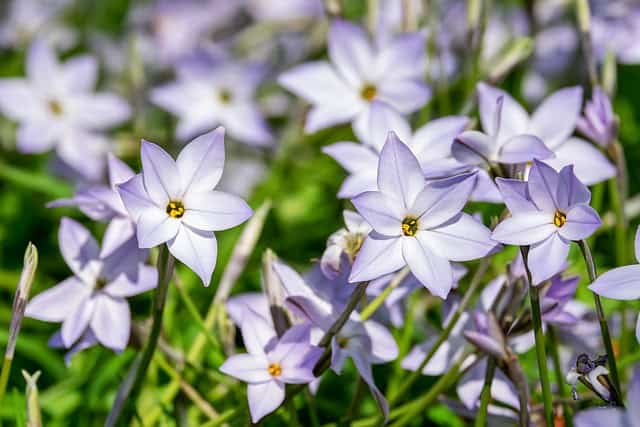
Spring Starflower (Ipheion uniflorum), often celebrated for its enchanting appearance, emerges as one of the delightful harbingers of spring after winter’s retreat. This lovely bulbous perennial showcases star-shaped flowers that can vary in color from pure white to soft shades of blue and lavender, often boasting a striking yellow center. Blooming typically from late winter to early spring, Spring Starflowers add a celestial touch to gardens just as snow begins to melt and the earth awakens.
These hardy bulbs are adapted to thrive in well-draining, loamy soils and prefer full sun to partial shade. They can naturalize beautifully, multiplying over time to form charming clusters that create a shimmering sea of color in garden beds and borders. Their ability to thrive in various conditions—including drought-tolerant setups—makes them an excellent choice for both traditional and xeriscape gardens. Additionally, with their sweet fragrance, Spring Starflowers attract early pollinators like bees, reinforcing the essential role of flowers in maintaining biodiversity.
Historically, Spring Starflowers have found a place in various cultural references, symbolizing renewal and the promise of new beginnings. Their ethereal beauty and resilience against the lingering chill of winter make them ideal candidates for early spring displays, inspiring hope and joy in gardeners eager for seasonal change. Incorporating Spring Starflowers brings not only visual allure but also a sense of optimism that emerges with the first hints of warmth in the air.
Violas
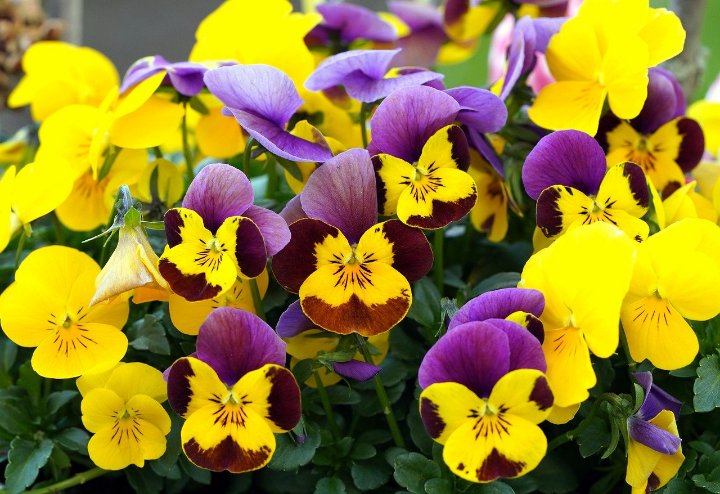
Violas (Viola tricolor) are charming winter flowers that provide a colorful and cheerful presence in gardens throughout the cooler months. Renowned for their vibrant hues and petite, delightful blooms, Violas are often used in bedding and container displays to add color where other flowers have yet to emerge. With a wide spectrum of colors ranging from soft pastels to bold, bright shades, these resilient blooms can illuminate any dull winter landscape.
Violas prefer well-drained soil and thrive in both full sun and partial shade, making them incredibly versatile for various planting environments. They are cold-tolerant and can withstand frost, often continuing to bloom even during mild winters. Their continuous flowering habit means they can provide persistent color from late fall through spring, making them excellent companions for other winter flowers. Additionally, Violas are known for their delightful scent, which complements their visual appeal, attracting pollinators that ignite the garden’s ecosystem.
Culturally, Violas have a rich history, often associated with thoughts of love and affection in literature and art. They are featured in various legends and folktales as symbols of loyalty, which makes them a thoughtful addition for those looking to impart a deeper message alongside their beauty. By choosing Violas for their winter gardens, gardeners can embrace a floral symbol of connection and sentiment, enhancing the emotional depth of their winter landscapes.
Winter Aconite

Winter Aconite (Eranthis hyemalis) is a cheerful evergreen perennial that adds a burst of sunshine to winter gardens with its bright yellow flowers. Blooming from late winter to early spring, this early riser pokes through the remnants of snow, providing a beautiful sight of gold against the stark whiteness of winter. Its unique cup-shaped flowers open up to look like little chalices, creating a joyous contrast with the typically drab winter landscape.
Winter Aconites thrive in well-drained soils that are rich in organic matter and perform best in partial shade, making them suitable for woodland gardens or areas where sunlight is filtered. They tend to spread and form colonies when planted in suitable conditions, creating a radiant carpet of yellow that mimics the warmth of spring sunshine. Having the ability to tolerate frost, these delightful flowers enhance the resilience of winter gardens, knowing that they will continue to bloom even in lower temperatures.
Beyond their bright appearance, Winter Aconites hold significance in various cultural contexts where they symbolize new beginnings and rebirth. These flowers are often among the first to emerge after winter’s frost, serving as a reminder of the cyclic nature of the seasons and the eventual arrival of spring. Incorporating Winter Aconites into a winter flower garden imbues the landscape with warmth, optimism, and the promise of renewal as the months progress.
Winter Heath

Winter Heath (Erica carnea), also known as winter flowering heather, is a captivating evergreen shrub that flourishes during the cold winter months. With its delicate pink and white flowers, Winter Heath is a true harbinger of spring, often blooming from late winter into early spring. This low-growing plant creates a lush carpet of color and texture, making it a popular choice for winter gardens and landscapes. In addition to its ornamental appeal, Winter Heath provides important ecological benefits by attracting early pollinators like bees, which seek out its nectar when few other flowers are available.
Winter Heath thrives best in well-drained, acidic soils and prefers full sun to partial shade, making it suitable for rock gardens, borders, and container plantings. Its hardiness allows it to withstand cold temperatures, making it an excellent choice for gardeners in cooler climates. This adaptable shrub can also be pruned to maintain shape and promote denser growth, providing flexibility in landscape design.
Culturally, Winter Heath has roots in European traditions, where it symbolizes endurance and resilience—a fitting representation of nature’s ability to endure the harshness of winter. Additionally, this versatile plant can serve as ground cover or an accent plant, seamlessly blending into a variety of garden styles. Incorporating Winter Heath into your winter garden not only emphasizes beauty but also celebrates the enduring spirit of nature amid the chill of winter.
Winter Jasmine
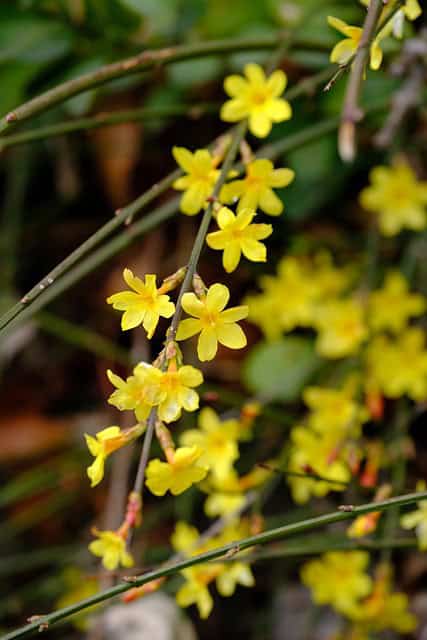
Winter Jasmine (Jasminum nudiflorum) is a delightful, deciduous shrub that sets itself apart with its vibrant yellow flowers that bloom against a backdrop of dull winter browns and grays. Typically flowering from late winter into early spring, Winter Jasmine fills the air with a sweet and inviting fragrance, creating a cheerful atmosphere in otherwise bleak conditions. With its trailing growth habit, Winter Jasmine can be used to drape over walls, trellises, or rock gardens, adding vertical interest and a splash of color to winter landscapes.
This hardy shrub thrives in a variety of soil types but prefers well-drained conditions. It does well in full sun to partial shade, making it highly versatile. Its resilience to cold and frost allows it to thrive in nearly any climate, establishing a firm presence in winter gardens and along pathways. Winter Jasmine can also be pruned back after blooming to encourage new growth and a bushier appearance, making it both functional and attractive.
In traditional Chinese medicine, Winter Jasmine has been valued for its medicinal properties for centuries, believed to promote overall vitality and immune support. Furthermore, this flower is celebrated in various cultures for its associations with fidelity and purity. By planting Winter Jasmine in a winter garden, gardeners not only benefit from its striking beauty and fragrance but also connect with a rich tapestry of cultural significance and historical value.
Winterberry Holly

Winterberry Holly (Ilex verticillata) is a deciduous holly species cherished for its vibrant red berries that provide a burst of color in the winter landscape. While the leaves fall during the colder months, the abundant berries remain, creating a striking contrast against snow-covered ground or dark evergreen foliage. This ability to produce a visual spectacle during winter makes Winterberry a favorite among gardeners, particularly those interested in creating wildlife-friendly habitats, as the berries are an important food source for birds and other wildlife in the colder months.
Winterberry Holly thrives in moist, acidic soils and prefers locations with full sun to partial shade. It can flourish in different environments but is particularly impactful when planted in groups, as this enables cross-pollination, leading to even more abundant berry production. Its upright growth habit makes it ideal for hedges or as a stand-alone specimen plant. With regular pruning, Winterberry can also be shaped to fit various landscape designs, enhancing its versatility.
Traditionally, Winterberry Holly has been used in holiday decorations, wreaths, and garlands, symbolizing hope, renewal, and festivity. Its bright berries add life to winter arrangements and serve to brighten indoor spaces as well. Incorporating Winterberry Holly into winter gardens not only yields visual beauty but also enriches the seasonal narrative of resilience and sustenance throughout the winter months.
Witch Hazel
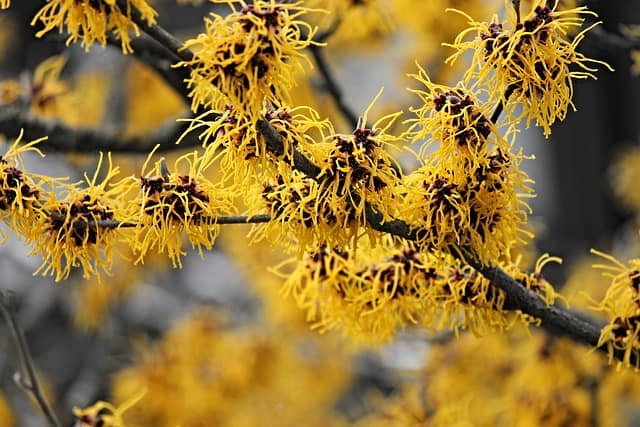
Witch Hazel (Hamamelis virginiana and its cultivated varieties) is a remarkable shrub or small tree that offers a unique contribution to the winter landscape with its striking flowers and intriguing medicinal properties. Blooming typically from late winter to early spring, Witch Hazel exhibits delicate, spider-like blooms in shades of yellow, orange, and red that unfurl on bare branches. This early spring spectacle is a true highlight of winter gardens, as the flowers often appear before the leaves, creating a stunning show of color against the otherwise muted background.
Witch Hazel thrives in well-drained soils and prefers full sun to partial shade, making it adaptable to various garden settings. It’s often used not only as an ornamental plant but also as a natural privacy screen or to soften the edges of more formal landscapes. This hardy plant is also resistant to many pests and diseases, making it a low-maintenance option for gardeners. In addition to its beauty, the fragrant blooms of Witch Hazel release a sweet, herbal scent that is particularly appealing to early pollinators.
Culturally, Witch Hazel holds significance in both herbal medicine and traditional practices. The plant’s bark and leaves are well-known for their astringent properties, historically used to treat various ailments, from skin irritations to bruises. The distilled extract from its bark is a popular remedy and can be found in many skincare products today. Furthermore, folklore surrounding Witch Hazel often associates it with protection and healing, adding an element of mystique to this enchanting plant. By incorporating Witch Hazel into winter gardens, gardeners gain a multifaceted addition that offers visual beauty, ecological benefits, and a rich historical context.
FAQ
Q: What are winter flowers?
A: Winter flowers are plants that bloom during the colder months, typically from late fall through early spring. They add color and beauty to gardens when most plants are dormant, and many are capable of surviving frost and snow. Common examples include Snowdrops, Winter Jasmine, and Witch Hazel.
Q: How do I care for winter flowers?
A: Care for winter flowers varies by species, but general guidelines include providing well-drained soil, ensuring proper sunlight exposure (ranging from full sun to partial shade), and watering as needed, especially during dry spells. Mulching can help protect roots and retain moisture. Each type of winter flower has specific needs, so it’s important to research the requirements of each plant.
Q: Can I plant winter flowers in containers?
A: Yes, many winter flowers thrive in containers, allowing for versatility in your garden design. Ensure that pots have proper drainage and choose varieties compatible with pot culture. Container gardening can help you create mobile arrangements that can be enjoyed throughout winter and into spring.
Q: Do winter flowers attract pollinators?
A: Yes, many winter flowers are important resources for early-season pollinators. Flowers such as Snowdrops and Witch Hazel provide nectar and pollen when food sources are scarce, supporting bees and other beneficial insects. Planting winter flowers contributes to maintaining biodiversity in your garden.
Q: Are winter flowers hardy in colder climates?
A: Many winter flowers are particularly hardy and can withstand cold temperatures and frost. Plants like Winter Aconite, Violas, and Winterberry Holly have adapted to survive challenging winter conditions, making them excellent choices for gardeners in colder climates. Selecting varieties that are suited to your hardiness zone will enhance their survival and performance.
Q: When is the best time to plant winter flowers?
A: The best time to plant winter flowers typically depends on the specific variety; many are planted in the fall before the ground freezes or in early spring as soon as the soil is workable. Always check individual species requirements for the most effective planting times.


